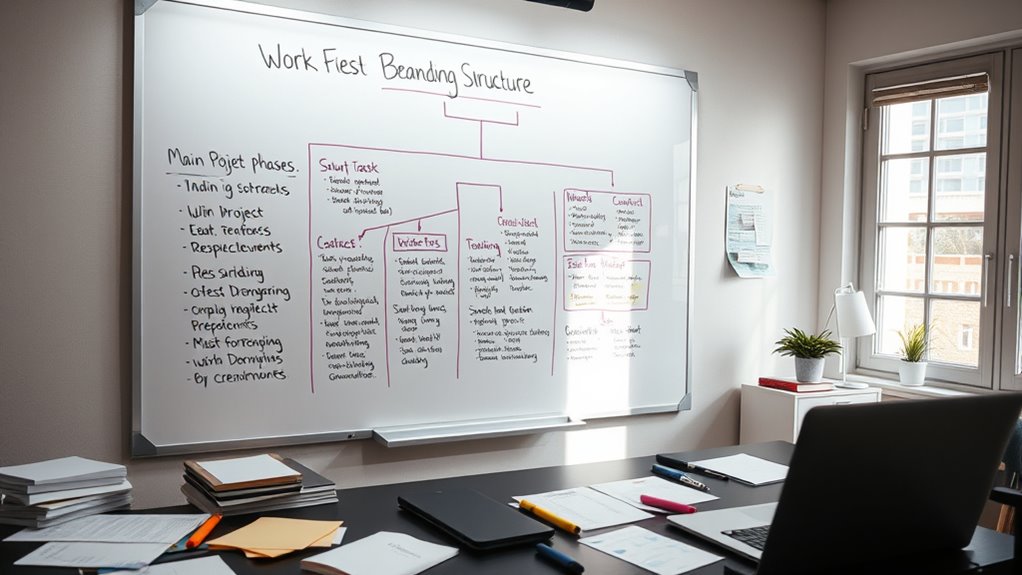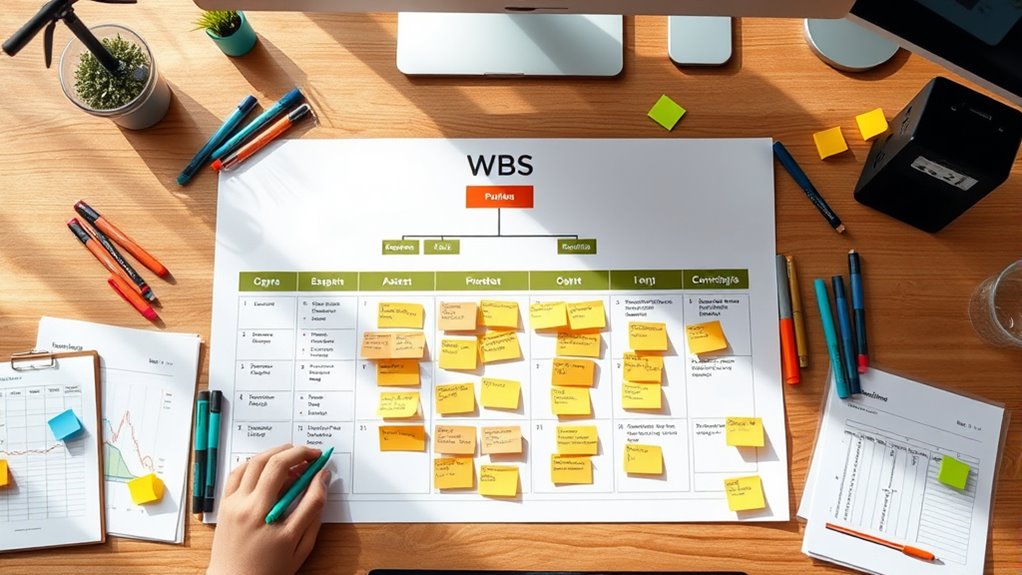A Work Breakdown Structure (WBS) helps you organize complex projects into manageable parts by breaking down overall goals into major deliverables, then smaller tasks. It uses a hierarchical format to clarify scope, responsibilities, and milestones while preventing scope creep. A clear WBS improves planning, resource allocation, and risk management. There are different structures and steps to develop an effective WBS. Keep exploring to understand how to create a WBS that keeps your project on track.
Key Takeaways
- WBS organizes complex projects by dividing them into manageable deliverables and tasks hierarchically.
- It clarifies project scope, defining what is included and excluded.
- WBS enhances planning, resource allocation, and progress tracking.
- Common structures include phased, deliverable-based, and functional approaches.
- Developing a WBS involves defining deliverables, engaging stakeholders, and regular review.
What Is a Work Breakdown Structure?

Have you ever wondered how complex projects stay organized and manageable? That’s where a work breakdown structure (WBS) comes in. It helps you clearly define the project scope by breaking it down into smaller, more manageable parts. It starts with the overall project goal and divides it into major deliverables. From there, each deliverable is further broken into tasks, making task definition precise and straightforward. This structured approach guarantees nothing gets overlooked and helps you assign responsibilities more effectively. By visualizing the entire project in a hierarchical format, you can easily see the relationship between different components. A well-crafted WBS keeps everyone aligned and focused, simplifying planning, scheduling, and tracking progress. Incorporating a detailed scope ensures all aspects of the project are thoroughly addressed and managed throughout the project lifecycle. Engaging in sound planning techniques can further optimize project execution and resource allocation. Additionally, understanding the importance of energetic alignment can enhance team collaboration and project success. Utilizing a project hierarchy also improves clarity by illustrating how individual tasks contribute to the overall goals.
The Purpose and Benefits of Using a WBS

Using a WBS helps you clearly define the project scope, so everyone understands what’s included and what’s not. It also makes planning more efficient by breaking tasks into manageable parts. With these benefits, you can stay organized and on track throughout your project. Additionally, understanding project requirements ensures all stakeholders are aligned on project goals and deliverables. Incorporating AI applications in learning and entertainment can further enhance project planning and execution by providing data-driven insights. Recognizing common project pitfalls can help prevent setbacks and keep the project progressing smoothly. Moreover, establishing cookie management practices can support better stakeholder communication and transparency during project execution. Being aware of signs of spoilage in lemon juice can also help ensure quality control in related projects involving food safety.
Clarifies Project Scope
Why is defining the project scope so essential? Clear scope clarification ensures everyone understands what’s included and what’s not, preventing scope creep. When you create a WBS, you break down the project into manageable parts, which helps you define the project scope precisely. This detailed breakdown makes it easier to identify deliverables and set realistic expectations. Without clear scope clarification, you risk missing key tasks or adding unnecessary work, which can delay your project or inflate costs. A well-structured WBS acts as a roadmap, aligning your team on the project’s boundaries. Additionally, incorporating detailed planning ensures all aspects of the project are accounted for from the start, further reducing the risk of scope issues. Recognizing the importance of project horsepower can help you allocate resources effectively and maintain progress. Moreover, understanding project scope contributes to better risk management throughout the project lifecycle. Establishing clear boundaries also supports effective communication among stakeholders, minimizing misunderstandings. Properly defining project scope also involves considering the scope of work in terms of deliverables and tasks to prevent scope creep. Ultimately, it helps you maintain focus, control scope changes, and deliver what’s promised, making your project more successful and predictable.
Enhances Planning Efficiency
A well-structured WBS considerably boosts planning efficiency by providing a clear framework for organizing all project tasks. With this structure, you can easily identify resource needs and allocate them effectively, preventing delays and overlaps. It simplifies tracking progress, so you stay on top of deadlines and milestones. Additionally, a detailed WBS fosters better stakeholder engagement by clearly illustrating how each component fits into the overall project. When everyone understands their responsibilities and the sequence of tasks, communication improves, and decision-making becomes more streamlined. This clarity reduces confusion and minimizes revisions, saving time and effort. Moreover, integrating resource allocation and comparative advantage principles into resource management can further enhance project efficiency. Applying attention to detail in reviewing the WBS ensures that no task or dependency is overlooked, leading to a more comprehensive project plan. Incorporating project management best practices can also help optimize the overall process. For example, considering the benefits of remote collaboration tools can facilitate coordination among geographically dispersed teams. Ultimately, using a WBS helps you plan more accurately, allocate resources wisely, and keep stakeholders aligned, resulting in a smoother, more efficient project execution.
Key Elements of a WBS

The key elements of a Work Breakdown Structure (WBS) serve as the building blocks that organize and define the scope of your project. These elements include deliverables, work packages, and tasks, which help you break down complex activities into manageable parts. Clear identification of deliverables allows you to allocate resources effectively, ensuring that each team member understands their responsibilities. Additionally, a well-structured WBS aids in risk management by highlighting potential problem areas early, allowing you to plan mitigations. Work packages are the smallest units within the WBS, making it easier to monitor progress and control costs. By focusing on these core elements, you create a solid foundation for successful project execution, improving clarity and facilitating better resource and risk management throughout your project lifecycle. Incorporating appliance maintenance plans into project planning can also help prevent unexpected issues during implementation. Moreover, understanding project scope and defining it precisely ensures that all stakeholders share a common vision and expectations for the project’s outcome.
Different Types of WBS Structures

Different types of WBS structures provide flexible ways to organize project work based on specific needs and project scope. Phased approaches break down work into sequential stages, helping you manage progress and dependencies clearly. This method suits projects with clear milestones or deliverables at each phase. Matrix formats, on the other hand, structure WBS elements both by deliverables and functional areas, enabling you to visualize cross-functional relationships and improve communication. You can also combine these structures to better fit complex projects. Choosing the right WBS structure depends on your project’s complexity, stakeholder requirements, and management preferences. Understanding these options allows you to tailor your WBS for clarity, control, and efficient project execution. Understanding different structures can enhance your ability to adapt to various project management challenges. Additionally, being aware of the company values and how they influence project organization can further improve your WBS design.
Steps to Develop an Effective WBS

How do you guarantee your WBS effectively captures all project work? Start by thoroughly defining project deliverables and breaking them down into manageable components. Engage team members and stakeholders to ensure exhaustive coverage, reducing overlooked tasks. Clearly identify each work package, aligning them with project objectives to facilitate resource allocation. Prioritize tasks to address potential risks early, integrating risk management strategies into the WBS structure. Use a hierarchical, logical approach to organize tasks, making sure each level provides clarity and detail. Regularly review and refine the WBS throughout the project, adapting to changes and new insights. This disciplined process promotes better resource planning, minimizes risks, and ensures every aspect of the project is accounted for from the start.
Tips for Creating Clear and Manageable Breakdowns

To create clear and manageable breakdowns, you should define each task specifically so everyone understands what’s involved. Use a hierarchical structure to organize tasks from broad to detailed, making it easier to track progress. Also, limit the scope of each breakdown to keep things focused and avoid overwhelming complexity.
Define Specific Tasks Clearly
Are your tasks clear enough to guide your team effectively? Clear tasks prevent confusion and ensure smooth progress. To achieve this, focus on defining each task precisely.
- Specify what needs to be done, avoiding vague language.
- Assign tasks based on team members’ strengths, aiding task delegation.
- Identify the resources required, supporting resource allocation.
- Set measurable outcomes and deadlines for accountability.
Use Hierarchical Structure
Have you considered organizing tasks into a hierarchical structure to make project management more straightforward? Using a hierarchical organization helps you break down complex projects into manageable parts through structured decomposition. Start with broad deliverables, then divide them into smaller, more specific tasks. This approach clarifies relationships between tasks and guarantees nothing gets overlooked. A clear hierarchy makes it easier to assign responsibilities, estimate time, and track progress. Keep your levels simple and logical, avoiding excessive detail at each stage. Visual tools like charts or diagrams can enhance understanding and communication. By applying a hierarchical structure, you create an intuitive, manageable breakdown that aligns tasks logically, ensuring your project stays organized and on track from start to finish.
Limit Breakdown Scope
When creating a work breakdown structure, it’s important to set clear boundaries for each level of detail. This scope limitation guarantees your breakdown remains manageable and focused. To establish effective breakdown boundaries, consider these tips:
- Define the scope of each component, avoiding overlaps that blur boundaries.
- Limit the number of sub-tasks at each level to maintain clarity.
- Focus on deliverables, not processes, to keep scope tight.
- Regularly review and adjust boundaries to prevent scope creep.
Common Mistakes to Avoid When Building a WBS

Building a WBS can seem straightforward, but overlooking common mistakes can compromise the entire project. One key error is allowing scope creep by not clearly defining or controlling deliverables at each level. When tasks are vague or poorly detailed, team members struggle to understand their responsibilities, leading to confusion and delays. Avoid creating overly broad or ambiguous work packages; instead, break tasks into specific, manageable units. Failing to involve stakeholders during development can result in missed requirements and misunderstandings. Also, neglecting to update or refine the WBS as the project evolves can cause misalignment. Keep your WBS clear, detailed, and aligned with project goals to prevent these pitfalls and ensure effective project execution.
How a WBS Supports Project Planning and Control

A well-constructed WBS serves as a foundation for effective project planning and control by providing a clear roadmap of all work components. This clarity helps you with:
- Allocating resources efficiently by pinpointing where each task needs support
- Managing risks proactively through visibility of potential problem areas
- Tracking progress precisely, ensuring tasks stay on schedule
- Adjusting plans quickly when issues arise, thanks to detailed task breakdowns
Tools and Software for Building a WBS

Ever wondered which tools can streamline the process of creating an all-encompassing WBS? Using software like project management tools with integrated Gantt charts helps you visualize task sequences, dependencies, and timelines clearly. Gantt charts allow you to see how work packages fit into the overall schedule, making adjustments simple. Meanwhile, mind mapping tools enable you to brainstorm and organize ideas visually, breaking down complex projects into manageable components. These tools facilitate collaboration, allowing team members to contribute ideas and refine the WBS in real-time. Whether you prefer Gantt charts for scheduling or mind mapping for initial brainstorming, leveraging the right software accelerates your planning process and guarantees your WBS is thorough, accurate, and easy to communicate.
Frequently Asked Questions
How Does a WBS Differ From a Project Schedule?
You see, a WBS differs from a project schedule because it focuses on task decomposition and scope breakdown. While a WBS breaks down the project into manageable parts, a project schedule sequences those tasks over time, assigning durations and deadlines. Fundamentally, the WBS helps you understand what needs to be done, and the schedule shows when and how you’ll do it. Both are essential for project planning and control.
Can a WBS Be Modified During Project Execution?
Yes, you can modify a WBS during project execution. Change flexibility is essential, so you should update the documentation to reflect any scope changes or new tasks. Regular reviews help identify necessary adjustments, ensuring the WBS remains accurate and useful. Making these updates keeps the project aligned with evolving requirements, improves clarity, and supports effective communication among team members and stakeholders.
What Skills Are Essential to Create an Effective WBS?
You need strong communication skills, stakeholder involvement, and organization to create an effective WBS. Clear team communication ensures everyone understands their tasks, while engaging stakeholders helps clarify project scope. You must be detail-oriented and skilled at breaking down complex activities into manageable parts. Being adaptable allows you to revise the WBS as needed. Remember, a well-crafted WBS is the backbone of project success—getting everyone on the same page is key.
How Does WBS Integration Impact Project Risk Management?
WBS integration enhances your project’s risk management by enabling better risk mitigation strategies and clearer stakeholder communication. When you seamlessly incorporate the WBS, you identify potential risks early, allowing for proactive planning. It also keeps stakeholders informed about task progress and risk areas, fostering transparency. This proactive approach helps you address issues promptly, reducing surprises and ensuring smoother project execution while maintaining stakeholder confidence throughout the process.
Are There Industry Standards for Developing a WBS?
Think of industry standards for developing a WBS as a trusty map guiding your project’s journey. These standards, like PMI or ISO, set best practices that guarantee clarity and consistency. By following them, you avoid getting lost in the chaos of scattered tasks and incomplete scopes. They act as a compass, helping you craft a WBS that’s structured, all-encompassing, and aligned with industry best practices, making your project smoother and more predictable.
Conclusion
Now that you understand the building blocks of a WBS, you’re armed with a map to navigate your project’s terrain. Think of it as a blueprint guiding you through the maze, ensuring no detail is overlooked. With a clear WBS in hand, you can steer your project smoothly, avoiding pitfalls and hitting your milestones with confidence. Embrace these fundamentals, and watch your project’s success unfold like a well-orchestrated symphony.









